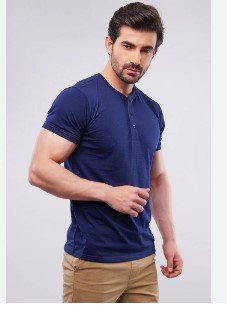The Essential Guide to Men’s Shirts: Styles, Fits, and Fabrics
Introduction
In the world of men’s fashion, the shirt is a cornerstone of style and sophistication. Whether it’s for a casual outing, a business meeting, or a formal event, the right shirt can elevate an outfit and make a strong impression. With countless styles, fits, and fabrics to choose from, finding the perfect shirt can be both exciting and overwhelming. In this blog, we’ll explore the different types of men’s shirts, how to choose the right fit, and the best fabrics to suit various occasions.
1. Types of Men’s Shirts

Understanding the different types of shirts available is key to building a versatile wardrobe. Here’s a breakdown of the most popular styles:
- Dress Shirts: The quintessential formal shirt, dress shirts are characterized by their collar, long sleeves, and button-down front. They are typically worn with a suit or dress pants and are available in various patterns, such as solids, stripes, and checks. Common collar styles include the spread collar, point collar, and button-down collar.
- Casual Shirts: Designed for a relaxed look, casual shirts come in a range of styles including button-down shirts, henley shirts, and short-sleeve options. These shirts can feature patterns like plaids, florals, and solids and are often paired with jeans or chinos for a laid-back yet stylish appearance.
- Oxford Shirts: A subtype of casual shirts, Oxford shirts are known for their durable, textured fabric and button-down collar. They’re versatile enough to be dressed up or down and are a staple in both casual and semi-formal wardrobes.
- Flannel Shirts: Made from soft, brushed fabric, flannel shirts are ideal for cooler weather. They usually feature plaid patterns and are perfect for a cozy, rugged look. Flannel shirts work well in casual settings and can be layered over t-shirts or worn on their own.
- Mandarin Collar Shirts: Also known as band collar shirts, these feature a collar that stands upright without flaps. They offer a sleek, modern look and are often worn in more fashion-forward or semi-formal settings.
2. Finding the Right Fit

A shirt’s fit is crucial to achieving a polished look. Here’s how to identify the different fits and determine which one is right for you:
- Slim Fit: Designed to hug the body without being too tight, the slim fit is ideal for those with a trim physique. It provides a contemporary, tailored appearance and is popular in both dress and casual shirts.
- Regular Fit: Offering a bit more room than the slim fit, the regular fit is versatile and comfortable. It provides a classic look that works well for most body types and is often chosen for business and casual shirts.
- Relaxed Fit: For a more laid-back style, the relaxed fit offers extra room and comfort. It’s perfect for casual wear and is often preferred for shirts that need to be worn for long periods or in informal settings.
3. Choosing the Right Fabric
The fabric of a shirt affects its appearance, comfort, and durability. Here are some common fabrics used in men’s shirts and their characteristics:
- Cotton: Known for its breathability and softness, cotton is a popular choice for both dress and casual shirts. It’s comfortable to wear and easy to care for, making it a versatile option for all seasons.
- Linen: Ideal for hot weather, linen shirts are lightweight and highly breathable. They have a natural, slightly wrinkled appearance that adds to their relaxed charm. Linen shirts are perfect for summer and beachwear.
- Polyester: Often blended with cotton, polyester adds durability and reduces wrinkling. Polyester shirts are easy to care for and maintain their shape, making them a practical choice for everyday wear.
- Flannel: Made from brushed cotton or a cotton blend, flannel is soft and warm, making it ideal for colder weather. It’s commonly used in casual, plaid shirts and offers a cozy, relaxed fit.
- Silk: For a touch of luxury, silk shirts offer a smooth, lustrous finish and are often used for formal occasions. They drape beautifully and provide a refined look but require more delicate care.
4. Styling Your Shirt

How you style your shirt can make a significant difference in your overall look. Here are some tips to help you make the most of your shirts:
- Tucking In: For dress shirts and formal occasions, tucking in your shirt creates a neat, polished look. In casual settings, an untucked shirt can add to a relaxed style, but be sure it’s cut for an untucked appearance.
- Layering: Incorporating shirts into layered outfits can add depth and interest to your look. Try pairing a dress shirt with a blazer or a casual shirt with a sweater for a stylish ensemble.
- Accessorizing: Adding accessories like ties, pocket squares, or statement watches can enhance your outfit. Choose accessories that complement your shirt’s color and pattern for a cohesive look.
Conclusion
Men’s shirts are a fundamental element of any wardrobe, offering endless possibilities for style and expression. By understanding the different types, fits, and fabrics available, you can choose shirts that not only suit your personal style but also accommodate various occasions. Whether you’re dressing up for a formal event or keeping it casual on the weekend, the right shirt can make all the difference in achieving a sharp, polished look. So, invest in quality shirts, experiment with different styles, and enjoy the timeless elegance they bring to your wardrobe.